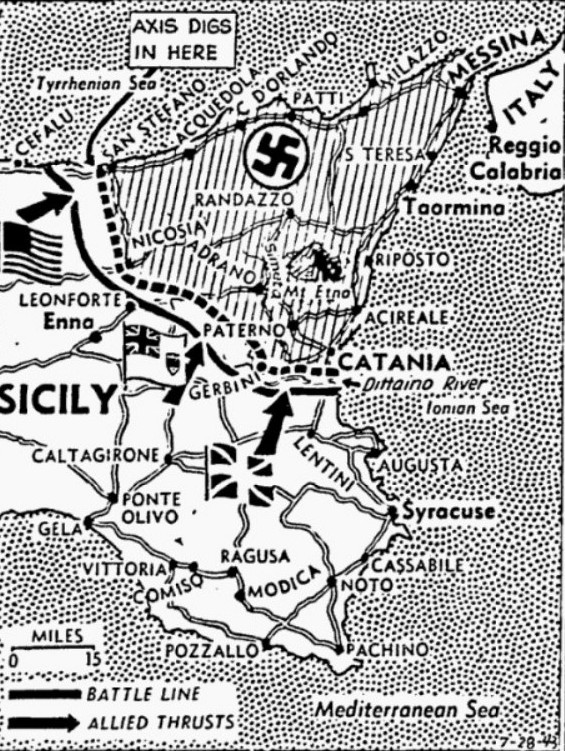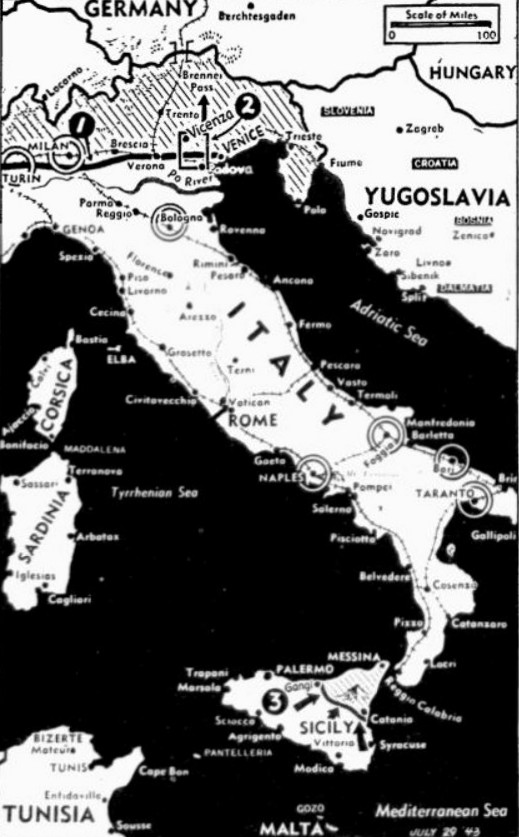The Pittsburgh Press (July 25, 1943)
Axis driven into corner of Sicily
American drive in west captures 40,000 and traps 50,000
By Reynolds Packard, United Press staff writer
Allies victorious in Sicily and Russia
Progress of the two-week invasion of Sicily which occupied all but 2,000 square miles of the northeast corner of the island is shown by the map above. As U.S. forces dash eastward Axis forces are now retreating into the Mt. Etna area for a final stand. Allied planes hammered airfields in Italy near Naples (lower left map), at Crotone and Salerno, and in the heel of the boot.
Allied HQ, North Africa –
U.S. troops, completing their lightning conquest of western Sicily with the capture of the port of Marsala, raced back eastward tonight to join a final land, air and sea assault against Axis forces crowded into a dead end only two miles from Europe.
The Americans had captured 40,000 prisoners and trapped 50,000 more enemy troops to assure the Allies a total bag of 110,000 for operations to date. They occupied the big west coast port of Marsala Friday without a fight and by now were believed in Trapani, northwest coast naval harbor, and Termini Immerse, 20 miles east of Palermo.
The Swiss radio, quoting reports from Algiers, said that Allied forces had arrived at Santo Stefano di Camastra, halfway between Palermo and Messina.
Canadian Prime Minister W. L. Mackenzie King told the House of Commons in Ottawa that the fall of the east coast stronghold of Catania “can be expected at any time.”
Bitter fight expected
All the remaining Axis elements able or willing to fight now were piling into a rough quadrilateral of less than 2,000 square miles extending around Mt. Etna down to besieged Catania and based on the Messina Strait where the next step backward was into Italy.
The Rome radio, indicating the Allies were landing forces on the east coast above Catania, said Axis planes had sunk an Allied ship off Acireale, north of Catania, which had been assisting “numerous landing troops in these waters.”
The enemy was reported putting up stiff rearguard actions as units which escaped the American surge struggled into this strong natural defense position and there was every indication the Germans would fight to the bitter end, as in Africa, to gain a little more time for Adolf Hitler.
Showdown near at hand
But a shakedown was at hand and it found the Americans rumbling eastward to assail the Axis right wing on the north coast while the Canadians inched back fiercely resisting elements of the German 15th Panzer Division in the center and the British 8th Army opened a furious new artillery barrage against Catania on the south.
Units of the Royal Navy, steaming inshore in support of the 8th Army, hurled fresh broadsides against the Germans’ defenses in the southern outskirts of Catania.
The Germans were reported making strenuous efforts to get in supplies of ammunition and gasoline and specialist troop reinforcements. Allied fighter planes Friday destroyed 10 landing craft off the north coast which were believed to have been bringing in supplies.
Supply convoy blasted
A few miles south of Rome, Royal Air Force Beaufighter bombers all but destroyed an enemy supply convoy, blowing up one merchantman and leaving another sinking and setting fire to two escort vessels including a destroyer. All resistance except possibly in isolated nests had ceased in western Sicily.
U.S. occupation forces still had a tremendous job of assembling and classifying captured equipment rounding up prisoners and arranging for their evacuation.
In London, military quarters said a general assault on the Axis last-ditch defenses in Sicily appeared imminent. They paid admiring tribute to the U.S. 7th Army’s advance of nearly 200 miles from their south coast beachheads to Palermo in 13 days.
Italian airfields blasted
U.S. Flying Fortresses blasted Leverano Airfield in the heel of Italy Friday in their most easterly raid from North African bases and shot down 12 from a group of 20-30 intercepting fighters.
Billy Mitchell medium bombers blasted the airdrome at Crotone on the instep and Marauders hit the Aquino Airfield north of Naples where a number of parked planes were destroyed.
The night before, RAF Wellingtons had bombed the railroad yards at Salerno and the airfield at Pratica di Mare near Naples.
In a large-scale offensive against the island of Crete, more than 100 light bombers and fighters from Middle East bases, some flown by Greek pilot, attacked ammunition dumps, tent camps, gun positions, transport and factories.
These widespread operations by both Allied African commands cost the Allies 21 planes while 17 Axis aircraft were shot down.
An Allied Navy communiqué announced that a British destroyer and a Greek destroyer damaged three enemy E-boats north of Augusta Tuesday night.
German commentators quoted in Berlin broadcasts refused to say whether the Axis planned to establish a bridgehead in Sicily or “whether further operations are to be reckoned with.” German troops are now exclusively in eastern Sicily “where the German-Italian tactic is to establish a strong barrier,” the broadcast said.



